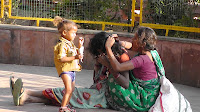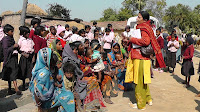We start tonight so no phone, no internet and no talking for 11 days. After being so busy in Bodhgaya I am looking forward to the next few days.
McLeod has grown so much even since I was last here
in 2010 but I lived here from 1996 until 2002. It was a quick exit in 2002 as
India and Pakistan had their nukes pointed at each other and all the embassies
were advising all foreigners to get out of the country ASAP. Anyway back then
McLeod had more trees and less concrete, more chia stalls than coffee Wi-Fi
cafes and more dharma bums and practitioners than rainbow dressed, matted haired,
backpackers just up from Goa and out of university. Times have changed and so
has this town but it still has to be the most international town with 4 streets
in the world. From the bus stop to the post office you can hear, Tibetan ,
Hindi, English Japanese Korean, all the European languages, Russian Mongolian,
Kashmiri, Chinese Korean, Vietnamese and Hebrew. So many people are drawn here
to see their Holinesses the Dalai Lama and Karmapa but also with the rise of the
middle classes in India there are many more tourists from the Punjab, Mumbai
and other parts of the country. It has a great climate in the summer when it is
way too hot in the rest of India, the Tibetan/multicultural environment is
relaxed and easy going and we can be grateful for this place through the
kindness of the Indian government and Himachal Pradesh local people who have
hosted the Tibetans here for just over 50 years now.
I learned so much being in this town, sure I
learned all about the Buddhist teachings but that knowledge is only valuable
when used in practice; i.e relating the teaching to ones experience of human
existence. Admitting old habits and dysfunctional desires, admitting I have an uncontrollable,
self concerned mind, but knowing that I can change it and develop. Then the
work begins, trying with great effort to develop the heart and mind, becoming
less selfish and more self aware, aware of oneself in relation to others and developing
concerned for all others, not just my friends and family. Taking responsibility for
my action, thoughts and words is tough especially when I am a feisty, stubborn
Scott and I have fallen down many times. (I have also learned to take myself
not so serious which has to be a good thing). Did I say this is not an easy
path, it is a lifelong practice and it is not a path of constant improvement
just coz I place my hand in reverence in front of the Dalai Lama or Buddha
statue. Only I can, through my own thought, words and actions, save myself.
This can be a tough pill for some to sallow but then again so many westerners
are attracted to Buddhism because of this aspect of self responsibility as well
as the lack of an outer savior and Buddhism’s scientific manner of
investigation of mind and the world. Buddhism makes sense to me and I am happy to have a
framework with which to understand this senseless and crazy world. Anyway
enough of this blah blah for now, where was I; oh yes
Today the retreat starts at 7 pm at Tushita, as
great centre just up the hill nestled in the woods; just a wee bit cold in the
winter but great in the spring.http://www.tushita.info/
Tushita is part of the Foundation for the Preservation of the Mahayana Tradition a centre which began in Nepal in the 70's and has now so many centres all over the world.http://www.fpmt.org/ It is a great organizations and offers great beginning classes.
Anyway I am off to explore, go down to the main Temple of the Dalai Lama, who just last week had Desmond TuTu for South Africa visit him http://www.youtube.com/watch?v=L9nJVrWk32E.
and probably talk with some old friends.












